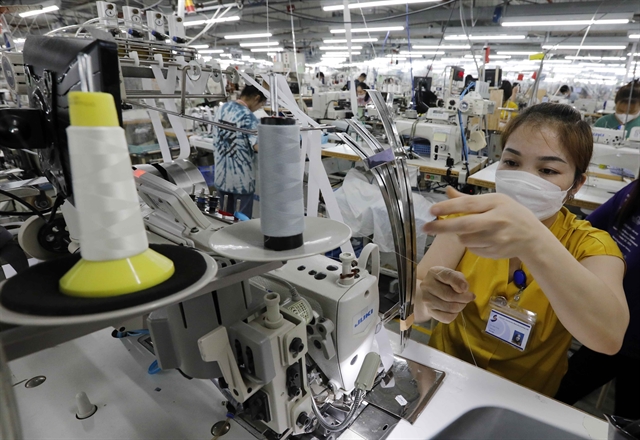 Economy
Economy


|
| Garments are one of the items with strong potential to expand exports to Eurasian markets. — VNA/VNS Photo Trần Việt |
HÀ NỘI — There is huge potential for Việt Nam to increase trade and investment cooperation between Việt Nam and Eurasia, powered by the formation of solid framework, including the free trade agreements with the Eurasian Economic Union (VN-EAEU FTA) and the EU (EVFTA), Tạ Hoàng Linh, Director of the European and America Market Department under the Ministry of Industry and Trade (MoIT) said at a trade forum on Friday.
The Việt Nam – Eurasia trade forum themed “Adapting to the market context – Unleashing potentials” aims to discuss solutions to realise cooperation opportunities with this vast inter-region of 28 countries, stretching from Eastern Europe to Central Asia, with a total area of 23.5 million sq.km, a population of 400 million and GDP of nearly US$4.5 trillion.
Although the bilateral trade saw declines in the last two years, by 9.7 per cent to $13.3 billion in 2022 and 6.5 per cent to $9 billion in the January – September period, Eurasia remained a potential market for Vietnamese enterprises, Linh said.
He pointed out that Việt Nam’s exports to this region accounted for just 2.4 per cent of the total export value of Việt Nam and 0.4 per cent of the region’s imports. The foreign direct investment from Eurasia made up for just 0.3 per cent of the total influx in Việt Nam.
The potential was powered by the formation of a solid framework as the foundation for the development of bilateral trade, including the VN-EAEU FTA, the EVFTA, and the EU – Việt Nam Investment Protection Agreement (EVIPA), he said.
Eurasia is also a region where a large number of Vietnamese live and do business, which will play an important role in connecting and promoting trade and investment exchanges between the two sides.
According to Shovgi Mehdizada, Ambassador of the Republic of Azerbaijan to Việt Nam, Azerbaijan, where East meets West, is regarded as the gateway to the Eurasian region. The North–South Transport Corridor and the Trans-Caspian International Transport Route or the Middle Corridor pass through the country.
Citing statistics that the trade turnover between Azerbaijan and Việt Nam increased from $185,755 in 2021 to $594,609 in 2022 and $462,347 in the first 10 months of this year, Shovgi said that there was large potential for collaboration in trade besides energy infrastructure and cultural exchanges.
“Both ASEAN and Turkic states share interests in fostering economic cooperation,” he stressed.
At the forum, Shovgi also introduced benefits for investors when investing in Azerbaijan’s Alat Free Economic Zone, including exemption from value-added tax and customs duties.
Kanat Tumysh, Ambassador Extraordinary and Plenipotentiary of the Republic of Kazakhstan to Việt Nam, said Kazakhstan and Việt Nam are the largest trade partners for each other in the respective regions of Central Asia and ASEAN.
“Now Việt Nam is a crucial economic partner of Kazakhstan in Asia,” he said, citing statistics that in 2022, bilateral trade increased by 23 per cent compared to 2021. Bilateral trade was 2.7 times higher in the first eight months of 2023 than the same period of 2022 and is on track to achieve several billions in US dollars.
“We believe that there is still a big potential for expanding our economic interaction,” he said.
As Kazakhstan accounts for 80 per cent of all continental traffic between China and Europe, providing the fastest export route for the delivery of goods and services from Asia to Europe and vice versa, Việt Nam could benefit from the transit of goods delivered to European markets through the Kazakh-Chinese terminal at the seaport Lianyungang.
He urged Vietnamese companies to actively use the potential of the Trans-Caspian International Transport Route - linking China to the EU which will cut almost in half the time it takes to transport goods via the Indian Ocean.
According to Nguyễn Thanh Hải, Vietnamese Trade Counselor in Bulgaria, there are opportunities to promote exports to six Western Balkans countries which are establishing the Western Balkans Common Regional Market as a step closer to membership of the EU.
These markets are not very highly demanding on product quality and competition is not as hard as in other EU markets.
Two-way trade between Việt Nam and six Balkan countries remains modest at below $20 million per year, in which Serbia is the largest export market with a turnover of $7 billion.
The presence of major export products of Việt Nam including garments, footwear and wooden furniture is still vague in these markets with a share of less than 1 per cent.
Notably, Vietnamese goods are penetrating Western Balkan through other countries in the EU such as Germany, Italy, Hungary and the Czech Republic.
Hải said that Việt Nam had advantages in promoting the export of processed coffee, cashews, frozen seafood, cement, steel and iron, plastics and rubber products to these markets.
Dương Hoàng Minh, Vietnamese Trade Counselor in Russia, Vietnamese enterprises should actively study market demand by participating in trade fairs to find cooperation opportunities.
In addition, enterprises should study their trade partners carefully before signing contracts to avoid fraud, Minh said that Việt Nam Trade Office would be willing to provide support to enterprises in verifying the status of their partners.
Nguyễn Anh Tuấn, Vice Chairman of Vietjet Air and Deputy CEO of Sovico Group said that the Government should create favourable conditions for airlines to open new flight routes connecting Việt Nam with countries in the Eurasian region to promote economic and cultural exchanges.
Support would also be provided to enable Vietnamese enterprises to participate in e-commerce platforms of Eurasian countries to expand exports. — VNS




